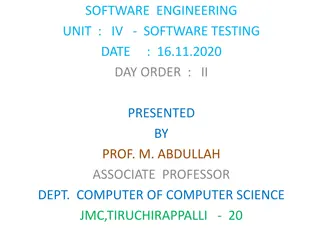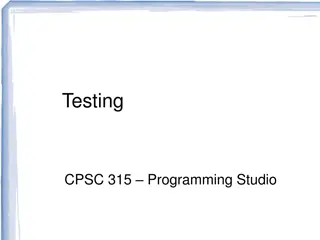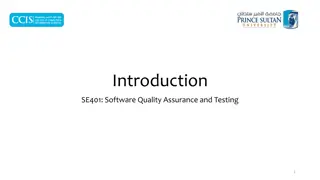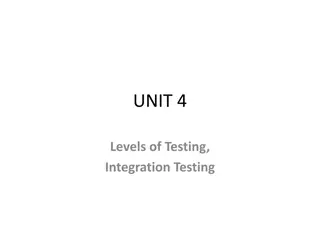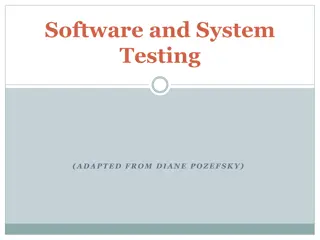
Software Testing Overview: Objectives, Goals, and Methodologies
Explore the fundamental aspects of software testing, including objectives, goals, and methodologies. Understand the importance of detecting faults, establishing confidence in software, and evaluating its properties for reliability, performance, memory usage, security, and usability.
Download Presentation

Please find below an Image/Link to download the presentation.
The content on the website is provided AS IS for your information and personal use only. It may not be sold, licensed, or shared on other websites without obtaining consent from the author. If you encounter any issues during the download, it is possible that the publisher has removed the file from their server.
You are allowed to download the files provided on this website for personal or commercial use, subject to the condition that they are used lawfully. All files are the property of their respective owners.
The content on the website is provided AS IS for your information and personal use only. It may not be sold, licensed, or shared on other websites without obtaining consent from the author.
E N D
Presentation Transcript
Vidya Pratishthans Arts, Science & Commerce College, Baramati. T.Y.B.B.A.(C.A.) Software Testing Presented By: Asst. Prof. Shinde V.V.
CONTENT Introduction What is Software Testing ? Objectives of Testing Goals of Testing Testing Methodologies Software Testing lifecycle Phases Testing Levels Types of Performance Testing Conclusion
INTRODUCTION Testing is a process used to help identify the correctness, completeness and quality of developed computer software. With that in mind, testing can never completely establish the correctness of computer software. There are many approaches to software testing from using alm tools to automated testing, but effective testing of complex products is essentially a process of investigation, not merely a matter of creating and following rote procedure.
WHAT IS SOFTWARE TESTING? Executing software in a simulated or real environment, using inputs selected somehow.
OBJECTIVES OF TESTING Uncover as many as errors (or bugs) as possible in a given product. Demonstrate a given software product matching its requirement specifications. Validate the quality of a software testing using the minimum cost and efforts. Generate high quality test cases, perform effective tests, and issue correct and helpful problem reports.
ERROR, BUG, FAULT & FAILURE Error : It is a human action that produces the incorrect result that produces a fault. Bug : The presence of error at the time of execution of the software. Fault : State of software caused by an error. Failure : Deviation of the software from its expected result. It is an event.
GOALS OF TESTING Detect faults Establish confidence in software Evaluate properties of software Reliability Performance Memory Usage Security Usability
TESTING METHODOLOGIES White box testing Black-box testing
White box testing Knowledge of the internal program design and code required. Tests are based on coverage of code statements, branches, paths, conditions. Black box testing No knowledge of internal program design or code required. Tests are based on requirements and functionality.
WHITE-BOX TESTING Test data Tests Derives Component code Test outputs
SOFTWARE TESTING LIFECYCLE - PHASES Requirements study Test Case Design and Development Test Execution Test Closure Test Process Analysis
REQUIREMENTS STUDY Testing Cycle starts with the study of client s requirements. Understanding of the requirements is very essential for testing the product.
ANALYSIS & PLANNING Test objective and coverage Overall schedule Standards and Methodologies Resources required, including necessary training Roles and responsibilities of the team members Tools used
Test Case Design and Development Component Identification Test Specification Design Test Specification Review Test Execution Code Review Test execution and evaluation Performance and simulation
Test Closure Test summary report Project De-brief Project Documentation Test Process Analysis Analysis done on the reports and improving the application s performance by implementing new technology and additional features.
TESTING LEVELS Unit testing Integration testing System testing
UNIT TESTING Tests each module individually. Follows a white box testing (Logic of the program). Done by developers.
INTEGRATION TESTING Once all the modules have been unit tested, integration testing is performed. It is systematic testing. Produce tests to identify errors associated with interfacing. Types: Big Bang Integration testing Top Down Integration testing Bottom Up Integration testing Mixed Integration testing
SYSTEM TESTING The system as a whole is tested to uncover requirement errors. Verifies that all system elements work properly and that overall system function and performance has been achieved. Types: Alpha Testing Beta Testing Acceptance Testing Performance Testing
Alpha Testing It is carried out by the test team within the developing organization . Beta Testing It is performed by a selected group of friendly customers. Acceptance Testing It is performed by the customer to determine whether to accept or reject the delivery of the system. Performance Testing It is carried out to check whether the system meets the nonfunctional requirements identified in the SRS document.
TYPES OF PERFORMANCE TESTING Stress Testing Volume Testing Configuration Testing Compatibility Testing Regression Testing Recovery Testing Maintenance Testing Documentation Testing Usability Testing
CONCLUSION In order to be cost effective, the testing must be concentrated on areas where it will be most effective. The testing should be planned such that when testing is stopped for whatever reason, the most effective testing in the time allotted has already been done. The absence of an organizational testing policy may result in too much effort and money will be spent on testing, attempting to achieve a level of quality that is impossible or unnecessary.
REFERENCE www.google.com www.wikipedia.com www.studymafia.org






